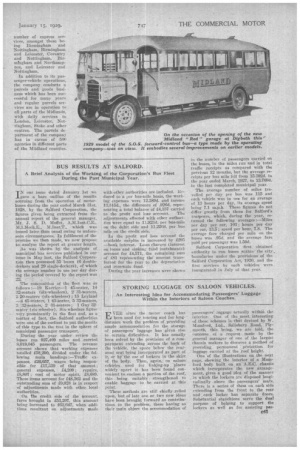STORING LUGGAGE ON SALOON VEHICLES.
Page 25

Page 26

If you've noticed an error in this article please click here to report it so we can fix it.
An Interesting Idea for Accommodating Passengers' Luggage Within the Interiors of Saloon Coaches.
VEIt since the motor coach has
been used for touring anti for loag-distance work the problem of providing ample accommodation for the storage of passengers' luggage has given rise to certain difficulties.. It has usually been solved by the provision -of a compartment extending across the hack of the vehicle, the space below the rearmost seat being incarpprated as.part of it, or by-the use of lockers in the skirt of the body. Then, again,: on saloon vehicles used for linking-up places widely apart it has been' found convenient to .enclose a portion of the-roof, this being-, suitably strengthened to enable baggage to be carried at this pcint. These methods are still chiefly relied upon,but of late one or two now ideas have been brought forward as contributions to the problem, these having as their main object the accommodation of
passengers' luggage actually withifl the interior. One of the most interesting of these schemes is -that devised by W. Mumford, Ltd.,. Salisbury Road, Plymouth, this 'being, we are told, the outcome of a rem:test made by the general manager of one of the largest chassis makers to discover a method of Providing permanent • ptoteetion for luggage carried at the 'roof 'height.
One of the illustrations On the net page, showing•the interior of ,a Mtpitford body built on an A.E.C. chassis which incorporates the new arrangement, gives a good idea of the Manner in which the lockers are dittinised longitudinally . above . the passengers' teats. There is a series of them on each side extending from the front to the rear ands suchlocker has separate doors. Subitantial stanchions serve the 'dna/ purpose of helping to 'support the lockers as well as for assisting pas stingersmovements. The space in the lockers is sufficient to accommodate a sill t=Case.
Although the luggage is accommodated within the interior of the body, the external appearance of the coachis not in any way altered, Whilst headroom in the interior is ample, particularly in the gangway, by reason of the fact that a clerestory form of cool construction is adopted.
This particular Delumford body ii built to seat 23 passengers and, in the main, the seats are disposed in the orthodox fashion. There are four pairs of transverse seats, each for two peoPle, on each side of the eentral gangway and another seat for two People behind them—this being opposite the rear door on the near side -and not
cciineeted to the off-side framework—the seating complement being brought up to its ',maximum by a . . .fnU-wiilth seat amiss the rear.
All the cushion and squab frames ste of . the Lace Webb double sprung variety and they are all upholstered in
deCorative moquette; Each seat has a foot rest in front 1-)f it.. This baciq of each seat with, -of course, the exdcption of the rearmost one is equip Jed with a flush-fitting folding table, the operation of which is .controlled by nickel-plated quadrants ; two ashtrays are also fitted to the seat backs.
The questions of ventilation and interior lighting have both been well thought out. 86 far as the former is concerned, the roof is provided with three Ashanco air extraetorS, as well as four glass ventilators, which are each 11.ins, long by S -ins. wide.. Both the doors and the sides of the . body are fitted with frameless lights, the rais-ng and lowering of which are controlled by means of Rawlings patents lifts. As louvre ventilators 'are".fitted above the main side lights, these can be partly opened without the risk of rain.. entering.
In the matter of lighting, nickelplated finger lamps are fitted to the side pillars for Operation by individual passengers, whilst there are three roof lamps combined with the under-grids of the Ashanco ventilators. In addition, there tire two large lamps in the c42 corners of the clothed section at the rear.
There are two doors for the passengers' vise on the near side, whilst the driver reaches his forward-control cabin through a door on the off side. There is a sliding glass window in the rear of the cab so that communication can be made with the interior of the body. The cab is fitted with rigid allweather-type side curtains. An interesting point is that the spare wheel is housed in a compartment immediately behind the driver.
The floor of the body is covered with Nairn' s I-in. cork carpet, whilst the centre aisle is also provided with an easily detachable grey pile carpet. T,he main panels of the body are of ISgauge aluminium, the corner 'panels bring of hand-beaten steel. A pleasing effect is given to the finish of the body by the adoption of a three-colour scheme and 2-in, gold linings.
































